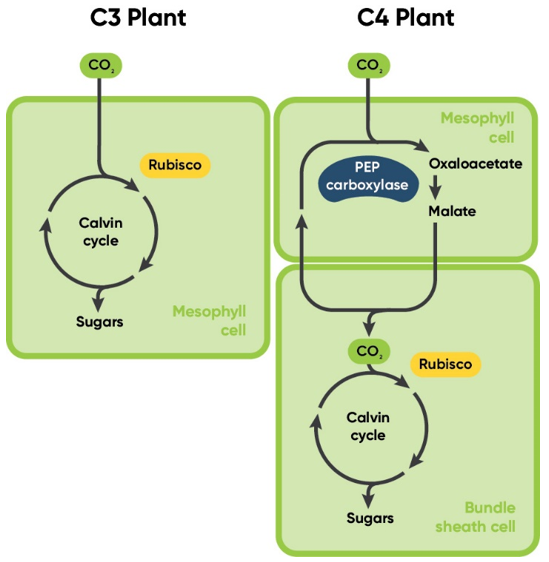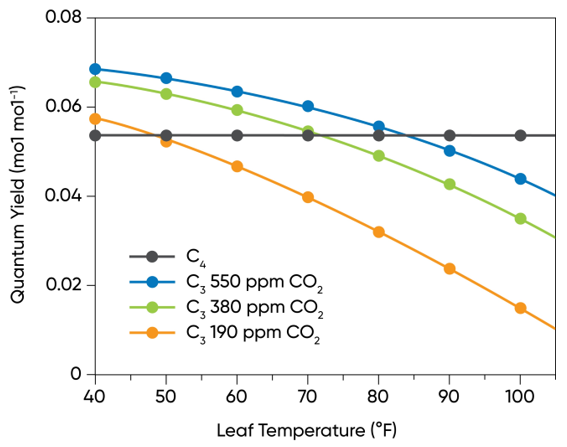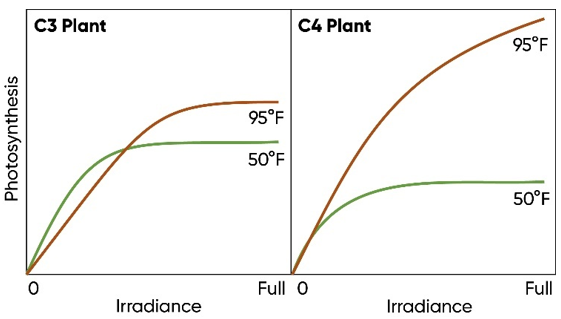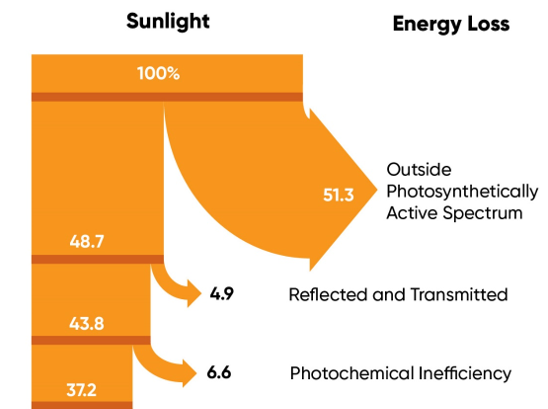2/28/2024
C3 and C4 Photosynthesis – Implications for Crop Production

Crop Insights
Written by Mark Jeschke, Ph.D., Pioneer Agronomy Manager
Key Points
- C3 and C4 carbon fixation are two different pathways by which plants convert carbon dioxide (CO2) from the atmosphere into organic compounds.
- The majority of plant species use C3 photosynthesis, which has a flaw that causes a loss of energy through a process known as photorespiration.
- A relatively small percentage of plant species, known as C4 plants, have evolved a modification to their carbon fixation pathway that allows them to greatly reduce energy lost to photorespiration.
- The improved efficiency of C4 plants comes with an added energy cost, so it is not always advantageous – which photosynthetic pathway is more energetically favorable depends on environmental conditions.
- The C4 pathway allows crops like corn and sugarcane to be more productive, but the overall efficiency with which plants convert light energy into biomass is still relatively low, for both C3 and C4 pathways.
- Current research is focused on using biotechnology tools to improve the efficiency of photosynthesis and increase the yield potential of important crops.
Converting Light Into Yield
Photosynthesis is the process by which plants transform light energy into chemical energy. In crop production, maximizing the rate and duration of photosynthesis over the course of growing season is critical to achieving the greatest possible yield potential because it determines the total amount of resources available to carry out biochemical processes and build plant components, including harvestable yield.
Not all plants carry out photosynthesis in exactly the same way though. Certain steps of the process differ in important ways among major crop species, which has implications for energy efficiency, stress tolerance, and yield potential. Scientific advances over the past couple of decades have increased our understanding of photosynthesis and fueled interest in modifying and improving it to increase yields of agricultural crops.
Carbon Fixation
The most important way that photosynthesis differs among crop species in the carbon fixation pathway. Carbon fixation is the process in photosynthesis by which plants convert carbon dioxide (CO2) from the atmosphere into organic compounds. This set of enzymatically regulated chemical reactions is commonly referred to as the “dark reactions,” although this term is something of a misnomer, as it only means that the reactions are not dependent on light to proceed, not that they exclusively occur at night. C3 and C4 carbon fixation (also written C3 and C4) are two different pathways used by plants in this process (Figure 1). The numbers in the names refer to the number of carbon atoms in the molecules produced in the first step of carbon fixation:
- In C3 plants, the product of the first step is 3-phosphoglycerate, a 3-carbon acid.
- In C4 plants, the first product is oxaloacetate, which has 4 carbon atoms.
The majority of plant species use C3 photosynthesis; however, a small number of species – including important crop species such as corn, sorghum, and sugarcane – use C4 photosynthesis. This distinction is important in crop production because the photosynthetic pathway used by a crop affects its photosynthetic efficiency, optimal environmental conditions, tolerance to stress, and yield potential.
Figure 1. Comparison of major steps in the carbon fixation pathways of C3 and C4 plants. Review a larger image.
C3 Photosynthesis
Of the more than 300,000 known plant species on earth, the vast majority (~90%) use the C3 photosynthetic pathway. C3 plants incorporate CO2 into carbohydrates using the photosynthetic carbon reduction (PCR) cycle, also known as the Calvin cycle. The key enzyme responsible for carbon fixation in C3 plants is ribulose-1,5-bisphosphate carboxylase/oxygenase (commonly referred to as RuBisCO), which converts CO2 and ribulose bisphosphate (RuBP, a 5-carbon sugar) into two molecules of 3-phosphoglycerate (PGA).
The Problem with RuBisCO
The problem with C3 photosynthesis is that RuBisCO not only reacts with CO2 (the desired reaction) but also with oxygen, which it does about 20-25% of the time. When RuBisCO reacts with oxygen, the combination of RuBP with O2 produces one molecule of PGA and a 2-carbon molecule called 2-phosphoglycolate, a toxic compound which the plant must recycle through a process known as photorespiration. Photorespiration is a wasteful process that consumes energy and results in a portion of fixed carbon being re-released as CO2. The process also produces ammonia, which the plant must expend energy to detoxify.

Figure 2. Soybeans, wheat, and rice – as well as most other crop species – utilize the C3 carbon fixation pathway.
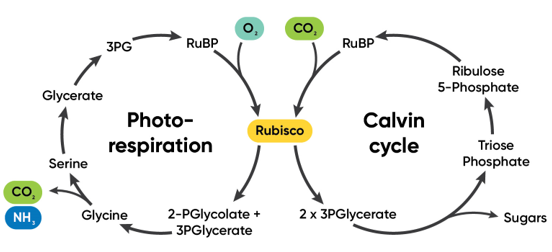
Figure 3. Calvin cycle and photorespiration pathways. Review a larger image.
C4 Photosynthesis
A relatively small percentage of plant species (~3%) have evolved a modification to their carbon fixation pathway that allows them to greatly reduce energy lost to photorespiration by adding an additional step ahead of the Calvin cycle. C4 plants have a distinctive leaf anatomy (called Kranz anatomy) that allows them to physically separate the steps involved in carbon fixation between two types of cells: mesophyll cells and bundle-sheath cells (Figure 1).

Figure 4. Only a few major crops utilize the C4 carbon fixation pathway: corn, sorghum, sugarcane, and millet.
An Extra Step to Improve Carbon Fixation
In C4 plants, the initial step in carbon fixation is carried out by an enzyme called phosphoenolpyruvate carboxylase (PEPC) in the mesophyll cells, which are located close to the stomata where carbon dioxide and oxygen enter the plant. PEPC has a high affinity for CO2 and is, therefore, much less likely to react with oxygen molecules than RuBisCO. PEPC fixes carbon dioxide into a 4-carbon molecule called oxaloacetate which is then converted to other 4-carbon acids (malate or aspartate) that are transported into the bundle sheath cells that contain Rubisco. Once in the bundle sheath cells, the C4 acids are decarboxylated to generate CO2 – which reacts with RuBisCO – as well as a C3 compound that returns to the mesophyll to repeat the cycle.
This process functions somewhat like a supercharger for carbon fixation – it increases the concentration of CO2 in the bundle sheath cells to a level where the oxygenase reaction of RuBisCO is negligible, thus making carbon fixation much more efficient. This feature allows C4 plants to be far more productive. Although they comprise less than 3% of known plant species, their greater efficiency allows them to carry out 20-30% of global terrestrial carbon fixation (Lloyd and Farquhar, 1994).
Improved Efficiency Comes with a Cost
The greater efficiency and productivity of C4 carbon fixation does not come for free, however. There is an additional energy cost to the plant that comes with adding the CO2-concentrating step ahead of the Calvin cycle. Consequently, C4 carbon fixation does not constitute an across-the-board advantage in all circumstances. Which photosynthetic pathway is more energetically favorable depends on environmental conditions.
Advantages and Tradeoffs
Cool Temperatures, High CO2, Low Light = C3 Advantage
The energy cost associated with C4 carbon fixation means that C3 plants retain an advantage in overall efficiency under conditions where photorespiration is naturally suppressed, such has higher ambient CO2 and cooler temperatures (Osborne and Beerling, 2006). As photorespiration increases with higher temperatures and lower CO2 levels, the relative advantage of C4 carbon fixation increases (Figure 5).
Figure 5. Modelled interaction between temperature and CO2 level on the photosynthetic quantum yields of C3 and C4 plants (Osborne and Beerling, 2006). Review a larger image.
There are a couple of reasons why photorespiration increases with temperature. As temperature increases, RuBisCO loses specificity for CO2 and increasingly reacts with oxygen. Higher temperatures also increase atmospheric water demand on the plant. When C3 plants close their stomata in response to water stress, RuBisCO will react more with oxygen as internal CO2 concentrations are drawn down, increasing the rate of photorespiration.
Hot, Dry, Full Sunlight, Low N = C4 Advantage
C4 plants have an advantage in environments prone to drought stress, high temperatures, and nitrogen deficiency. The CO2 concentrating mechanism of C4 plants gives them a greater ability to close their stomata in response to heat and drought stress and pull internal CO2 concentrations down to lower levels before photosynthesis slows and the stomata must be opened again.
Figure 6 shows generalized light response curves for C3 and C4 plants. At low temperatures, the C3 plant has a greater initial response to light and a higher light-saturated photosynthesis level, while the added energy cost of the CO2 concentration mechanism puts C4 plants at a disadvantage. Most C3 species reach light saturation at levels well below full sunlight. At higher temperatures, C4 plants attain much higher photosynthetic output and do not reach light saturation, even at full sunlight.
Figure 6. Generalized light response curves for C3 and C4 plants at low and high temperature. (Reproduced from Plants in Action, published by the Australian Society of Plant Scientists.) Review a larger image.
The greater nitrogen efficiency of C4 plants is primarily a function of the amount of N used in producing RuBisCO. Because RuBisCO operates with much greater efficiency in C4 plants, the plants can produce 60-80% less of it (Long 1999). Conversely, C3 plants must produce more RuBisCO, which uses more nitrogen; a not inconsequential investment, as RuBisCO accounts for nearly 50% of the total protein in leaf tissue of C3 plants (Cui, 2021).
Distribution of C3 and C4 Species
The global distribution of C3 and C4 species reflects their respective advantages. C4 species are most common in hot and dry environments such as tropical grasslands and savannas where their more efficient carbon fixation pathway provides the greatest advantage. C4 species also tend to thrive in ecosystems that experience frequent disturbance (such as wildfire), as their faster growth rate allows them to grow back more quickly. C3 plants tend to dominate in environments with lower growing season temperatures – such as higher elevations – and places where light intensity is limited, such as the understory of forests.
Evolution
The significant inefficiency that photorespiration creates in C3 plants raises the obvious question of why such a flawed pathway would evolve in the first place and why it persists in the majority of plant species today. The Calvin cycle first evolved in cyanobacteria over 2 billion years ago, at a point in Earth’s history when atmospheric CO2 concentrations were much higher than today, and oxygen levels were much lower. In that environment, the oxygenase activity of RuBisCO did not constitute a major inefficiency because there was very little oxygen in the atmosphere with which it could react (Erb and Zarzycki, 2018).
C4 carbon fixation is a much more recent evolutionary innovation, emerging between 25 and 32 million years ago at a point when lower CO2 and higher oxygen levels in the atmosphere made the oxygenase activity of RuBisCO much more of a liability. Today, there are around 8,100 known C4 species, most of which are grasses (~5,000); however, C4 species exist in at least 61 distinct evolutionary lineages of plants, making it a notable example of convergent evolution.
Impact On Crop Productivity
For crop species that utilize the C3 carbon fixation pathway, such as soybeans and wheat, the cost associated with photorespiration in terms of lost yield potential is substantial. Under current atmospheric CO2 levels, it is estimated that the energy lost through photorespiration reduces total U.S. soybean production by 36% and wheat production by 20% (Walker et al., 2016).
YIeld impact varies by geography and climate, with greater impacts occurring in warmer regions where photorespiration is higher. For example, yield loss in soybean is estimated to be over 50% in warmer southern states compared to 30-40% in northern latitudes.
Improving Photosynthesis
The substantial lost potential in global agricultural productivity attributable to photorespiration in C3 crops has led to considerable interest in the possibility of using biotechnology to reduce or eliminate photorespiration, which could dramatically increase yields of C3 crops.
Why Not Fix RuBisCO?
The most straightforward solution to the problem would be to simply fix RuBisCO – alter the enzyme in a way so that it reacts with CO2 but not oxygen, thus eliminating the problem of photorespiration. However, this does not appear to be possible. Research has shown an inverse relationship between CO2 specificity and catalytic rate – increasing the preference of the enzyme for CO2 also slows it down. A lower catalytic rate could be overcome by increasing the amount of RuBisCO in the plant, but with RuBisCO already accounting for nearly 50% of total protein in the leaf tissue of C3 plants, it’s not clear that this would be feasible either (Zhu et al., 2004). The fact that no version of RuBisCO that lacks oxygenase activity has ever been found in nature suggests that this may be an intractable problem with RuBisCO. If this feature of RuBisCO were possible to eliminate without harming the carboxylation function of the enzyme, evolution would likely have already done so rather than (repeatedly) evolve the imperfect workaround of the C4 carbon fixation pathway.
Can We Convert C3 Plants to C4?
A more feasible option may be to just replicate evolution’s solution to the problem by engineering a C4 carbon fixation pathway into C3 plants. This is not a simple proposition, given the specialized anatomy and biochemistry in leaves of C4 plants. However, the fact that C4 carbon fixation evolved independently numerous times in nature (with a few different biochemical variants of the pathway) offers hope that such a goal could be achievable. And the significant benefits that such an innovation could offer in terms of dramatically increased yields and greater resilience to drought stress has fueled considerable scientific interest in this area over the past 25 years.
C4 Rice Project
Efforts thus far to create a C4 version of a C3 crop have largely focused on rice due to its global importance as a major calorie source for around half of the world’s population. What is today known as the C4 Rice Project originated at a workshop convened by the International Rice Research Institute (IRRI) in 1999 to assess the feasibility of engineering the C4 carbon fixation pathway into rice. Scientists identified the need to better understand the specific changes to the genome responsible for the biochemical and anatomical features of C4 plants. The C4 pathway was discovered and elucidated through research conducted in the 1960s, but by the 1990s research on C4 photosynthesis had waned. A resurgence of research in this area with modern genetic tools was deemed necessary to achieve such an ambitious goal.
The C4 Rice Consortium was created in 2006 to lay out a research plan and the project received financial backing from the Bill and Melinda Gates Foundation in 2008. Research in this area continues to progress, and with a far more formidable set of DNA sequencing and genetic transformation tools than were available at the time of the project’s inception (Furbank et al., 2023).
Improving Radiation Use Efficiency
Improving photosynthetic efficiency of plants is often referred to as a “grand challenge” or “holy grail” of plant research in the 21st Century. Innovations that were at the core of the Green Revolution in the 20th Century – shortening the stems and increasing the harvest index in wheat and rice – involved changes to only a few genes. Photosynthesis, on the other hand, is a complex process involving numerous genes, making re-engineering it a challenging endeavor. Yet a growing sense that the strategies that enabled the Green Revolution have reached a plateau in yield improvement has led to greater focus on photosynthesis itself as the next frontier in crop improvement (Furbank et al., 2023).
There are four main factors that determine yield potential in crops (Covshoff and Hibberd 2012):
- Total solar radiation over the growing season.
- Efficiency of the plant in intercepting photosynthetically active radiation (PAR).
- Radiation use efficiency – the efficiency with which PAR is converted by the plant into dry matter.
- Harvest index – partitioning of dry matter to grain.
Yield improvements of the Green Revolution largely involved optimizing efficiency of light interception (though practices such as higher plant density) and increasing harvest index. Growers maximize seasonal solar radiation through timely planting and the use of full-season hybrids and varieties (to use as much of the growing season as possible). This leaves improving radiation use efficiency as the best opportunity for new genetic improvement (Covshoff and Hibberd 2012).
Room For Improvement
Engineering C4 photosynthesis into C3 crops is one way to work toward this goal, and a logical approach given that it involves utilizing a biochemical pathway that already exists in nature and offers the potential for dramatic yield gains in important crop species. Yet the fact is that neither photosynthetic pathway is particularly efficient. The efficiency with which plants convert light energy into biomass is relatively low, for both C3 and C4 pathways. The theoretical maximum for photosynthetic efficiency is 4.6% for C3 plants and 6% for C4 plants (at 30°C and 380 ppm atmospheric CO2) (Figure 7). Efficiencies that are actually achievable in the field over the course of a growing season are even less (Zhu et al., 2008). By comparison, current commercially available solar panels are generally 15-20% efficient, with some advanced technologies reaching close to 40%.
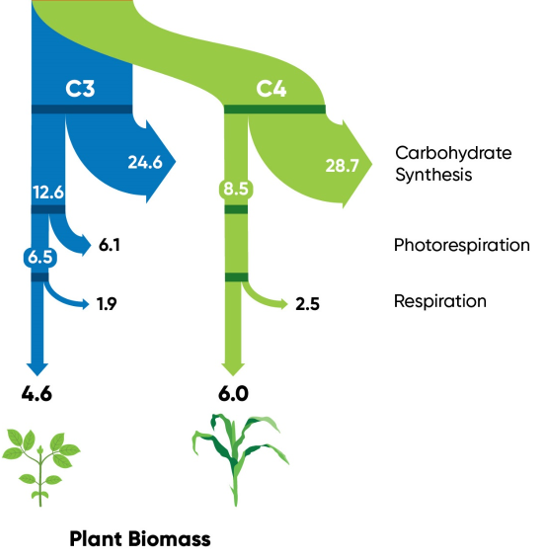
Figure 7. Minimum energy losses at each step of the plant photosynthetic process of C3 and C4 plants, from interception of radiation to the formation of stored chemical energy in biomass. Assumes a leaf temperature of 86°F and atmospheric CO2 concentration of 380 ppm (Zhu et al., 2008). Review a larger image.
Why is Photosynthesis So Inefficient?
One might expect that a biochemical pathway that has been ubiquitous in nature for hundreds of millions of years would be extremely optimized, given the countless generations of natural selection acting upon it. This makes the low efficiency of photosynthetic carbon fixation somewhat surprising. There are a couple of likely explanations for why this is the case.
First, evolution selects for survival, not maximum productivity. Photosynthetic rate is just one of many attributes that could be important in the life of a plant in determining its ability to successfully pass its genes on to the next generation. And which attributes are most important to the survival and successful reproduction of a given plant could vary considerably based on its environment.
Second, in the time since photosynthesis first evolved, Earth’s climate and atmospheric composition have undergone significant changes, which means that the selection pressures imposed on plants have not been static over time. Rubisco provides a very clear example of this – an attribute (oxygenase activity) that was not detrimental when it first evolved now is detrimental because of higher atmospheric oxygen.
Broader Efforts to Improve Photosynthesis
Considerable research has focused on RuBisCO as a limiting factor in photosynthetic efficiency; however, photosynthesis is a complex process with many steps and many possibilities for increasing efficiency and productivity. Realizing Increased Photosynthetic Efficiency (RIPE) is an international research project founded in 2012 focused on engineering crops to be more productive by improving photosynthesis. The development of sophisticated computer models has allowed scientists to simulate the process of photosynthesis and identify potential bottlenecks in the process (Zhu et al., 2016).
One such bottleneck identified by RIPE Project scientists involves the process by which plant photosynthetic systems respond to fluctuations in light level, as occurs when clouds pass overhead or a leaf within a crop canopy transitions in to and out of shade as the angle of incoming sunlight changes throughout the day. These adjustments are slow, taking several minutes and costing field crops up to 20% of their potential yield (Kromdijk et al., 2016). Scientists identified three proteins that, when increased, allowed plant leaves to adapt more quickly to fluctuations in light.
Impact Of Rising Carbon Dioxide
Research focused on improving photosynthetic efficiency and yield of crop plants is being conducted against a backdrop of rapidly increasing atmospheric CO2. The recent increase in atmospheric CO2 levels to over 420 ppm during the past 150 years, after fluctuating between 180 and 300 ppm over the prior million years, means that all plant life now exists in a world that is different from the one to which it is adapted (Figure 8). And continued CO2 emissions from fossil fuel burning mean that this concentration will continue to rise in coming decades. What does rising CO2 mean for productivity of C3 and C4 crop species and efforts to optimize photosynthetic efficiency?
Figure 8. Atmospheric CO2 concentration over the past 2,000 years based on ice core data (before 1958), and direct measurements taken at Mauna Loa and the South Pole (1958-present) (Keeling et al., 2001; MacFarling Meure et al., 2006). Review a larger image.
Impact on C3 Plants
Numerous research studies have examined the effects of elevated CO2 concentrations on crop growth and yield. In general, yields of C3 crops significantly increase at higher CO2 levels, although responses vary by crop and growing conditions (Toreti et al., 2020). Higher CO2 reduces the rate of photorespiration in C3 plants, increasing their photosynthetic efficiency.
In general, rising CO2 is expected to boost yields of C3 crops; however, it’s not necessarily as simple as more CO2 = more yield. A multiyear study on the effects of elevated CO2 (550 ppm) on soybeans found that total aboveground biomass increased by 22% but seed yield only increased by 9% due to a reduction in biomass partitioning to the seed (Bishop et al., 2015). Research has shown that C3 plants are not able to fully take advantage of higher atmospheric CO2 because their biochemical processes are optimized for CO2 levels that existed during the 20 million years preceding the industrial era (<300 ppm) and not the levels of today (>420 ppm) (Pearson and Palmer, 2000; Zhu et al., 2010).
Additionally, the CO2 fertilization effect in C3 plants can disappear under drought stress. A multiyear field study showed that the stimulation of soybean yield by elevated CO2 diminished to zero as drought intensified. Higher CO2 did not counteract the effect of severe drought stress on photosynthesis and yield because elevated CO2 interacted with drought to modify stomatal function and canopy energy balance (Gray et al., 2016).
Impact on C4 Plants
Yield of C4 crops generally would not be expected to respond to higher CO2 in the same way as C3 crops because photorespiration is already suppressed in the C4 carbon fixation pathway. Research has shown this to be the case, with no significant change in yield of C4 crops such as corn and sorghum under elevated CO2 when water supply was adequate. Under drought stress, however; elevated CO2 can confer an advantage in C4 plants. Higher CO2 leads to lower stomatal conductance (i.e., plants do not need to have their stomata open as much to take in adequate CO2), which reduces transpiration and increases water use efficiency (Toreti et al., 2020).
CO2 Effects vs. Climate Change Effects
Higher CO2 concentrations can benefit yields of both C3 and C4 crops under certain conditions; however, changes to Earth’s climate caused by higher CO2 will affect crop yields as well. Projected changes for the U.S. Corn Belt include increased frequency of drought stress during the summer due to higher temperatures and evapotranspiration, with precipitation concentrated into less frequent and more intense events (Angel et al., 2018). Globally, the net effect of higher CO2 levels and climate change on crop productivity is expected to be close to zero over the coming decades as positive and negative effects roughly cancel each other out, although important changes could occur at regional and local scales (Lobell and Gourdji, 2012).
References
- Angel, J., C. Swanston, B.M. Boustead, K.C. Conlon, K.R. Hall, J.L. Jorns, K.E. Kunkel, M.C. Lemos, B. Lofgren, T.A. Ontl, J. Posey, K. Stone, G. Takle, and D. Todey. 2018. Midwest. In Impacts, Risks, and Adaptation in the United States: Fourth National Climate Assessment, Volume II [Reidmiller, D.R., C.W. Avery, D.R. Easterling, K.E. Kunkel, K.L.M. Lewis, T.K. Maycock, and B.C. Stewart (eds.)]. U.S. Global Change Research Program, Washington, DC, USA, pp. 872–940. doi: 10.7930/NCA4.2018.CH21.
- Bishop, K.A., A.M. Betzelberger, S.P. Long, and E.A. Ainsworth. 2015. Is there potential to adapt soybean (Glycine max Merr.) to future [CO2]? An analysis of the yield of response of 18 genotypes to free-air CO2-enrichment. Plant Cell Environ. 38:1765-1774.
- Covshoff, S., and J.M. Hibberd. 2012. Integrating C4 photosynthesis into C3 crops to increase yield potential. Curr. Opin. Biotechnol. 23:209-214.
- Cui, H. 2021. Challenges and Approaches to Crop Improvement Through C3-to-C4 Engineering. Front. Plant Sci. 12:715391.
- Erb, T.J., and J. Zarzycki. 2018. A short history of RubisCO: The rise and fall (?) of Nature’s predominant CO2 fixing enzyme. Curr. Opin. Biotechnol. 49:100–107.
- Furbank, R., S. Kelly, and S. von Caemmerer. 2023. Photosynthesis and food security: the evolving story of C4 rice. Photosynthesis Research. 158:121-130.
- Gray, S.B., O. Dermody, S.P. Klein, A.M. Locke, J.M. McGrath, R.E. Paul, D.M. Rosenthal, U.M. Ruiz-Vera, M.H. Siebers, R. Strellner, E. A. Ainsworth, C.J. Bernacchi, S.P. Long, D.R. Ort, and A.D.B. Leakey. 2016. Intensifying drought eliminates the expected benefits of elevated carbon dioxide for soybean. Nature Plants, 2:16132.
- Keeling, C.D., S.C. Piper, R.B. Bacastow, M. Wahlen, T.P. Whorf, M. Heimann, and H.A. Meijer. 2001. Exchanges of atmospheric CO2 and 13CO2 with the terrestrial biosphere and oceans from 1978 to 2000. I. Global aspects, SIO Reference Series, No. 01-06, Scripps Institution of Oceanography, San Diego, 88 pages.
- Kromdijk, J., K. Glowacka, L. Leonelli, S.T. Gabilly, M. Iwai, K.K. Niyogi, and S.P. Long. 2016. Improving photosynthesis and crop productivity by accelerating recovery from photoprotection. Science, 354:857-861.
- Lloyd, J., and G.D. Farquhar. 1994. 13C discrimination during CO2 assimilation by the terrestrial biosphere. Oecologia 99:201-215.
- Lobell, D.B., and S.M. Gourdji. 2012. The influence of climate change on global crop productivity. Plant Physiology, 160:1686-1697.
- Long, S.P. 1999. Environmental responses. In: Sage R.F., Monson, R.K. eds. C4 plant biology. San Diego: Academic Press, 215-249.
- MacFarling Meure, C., D. Etheridge, C. Trudinger, P. Steele, R. Langenfelds, T. van Ommen, A. Smith, and J. Elkins. 2006. The Law Dome CO2, CH4 and N2O Ice Core Records Extended to 2000 years BP. Geophysical Research Letters, Vol. 33, No. 14, L14810
- Toreti, A., D. Deryng, F.N. Tubiello, C. Müller, B.A. Kimball, G. Moser, K. Boote, S. Asseng, T.A.M. Pugh, E. Vanuytrecht, H. Pleijel, H. Webber, J.L. Durand, F. Dentener, A. Ceglar, X. Wang, F. Badeck, R. Lecerf, G.W. Wall, M. van den Berg, P. Hoegy, R. Lopez-Lozano, M. Zampieri, S. Galmarini, G.J. O’Leary, R. Manderscheid, E.M. Contreras, and C. Rosenzweig. 2020. Narrowing uncertainties in the effects of elevated CO2 on crops. Nature Food, 1:775-782
- Walker, B.J., A. VanLoocke, C.J. Bernacchi, and D.R. Ort. 2016. The costs of photorespiration to food production now and in the future. Annu. Rev. Plant Biol. 2016. 67:107-129.
- Zhu, X.G., S.P. Long, and D.R. Ort. 2008. What is the maximum efficiency with which photosynthesis can convert solar energy into biomass? Curr. Opin. Biotechnol. 19:153-159.
- Zhu X.G, S.P. Long, and D.R. Ort. 2010. Improving Photosynthetic Efficiency for Greater Yield. Annual Review of Plant Biology. 61: 235-261. 10.1146/annurev-arplant-042809-112206.
- Zhu, X.G., J.P. Lynch, D.S. LeBauer, A.J. Millar, M. Stitt, and S.P. Long. 2016. Plants in silico: why, why now and what? – an integrative platform for plant systems biology research. Plant, Cell & Environment, 39: 1049–1057.
The foregoing is provided for informational use only. Please contact your Pioneer sales professional for information and suggestions specific to your operation. Product performance is variable and depends on many factors such as moisture and heat stress, soil type, management practices and environmental stress as well as disease and pest pressures. Individual results may vary.
Pioneer® brand products are provided subject to the terms and conditions of purchase which are part of the labeling and purchase documents.
